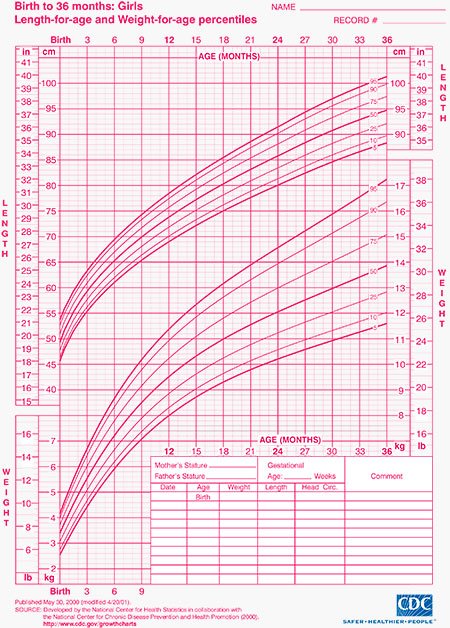Growth Charts
What is a growth chart?

- Growth charts provide a visual display of the rate of growth of an infant, child, or adolescent.
- Infant growth charts document length, weight, and head circumference. Children and adolescent growth charts document height, weight, and BMI (body mass index).
- Growth charts provide a unique long-term assessment of the overall health of the patient.
- Growth chart abnormalities would include children either "not on the chart" or an unanticipated acceleration or deceleration of the child's rate of growth over time.
How do you read a growth chart?

- Growth charts are a tool to visualize a child's rate of growth over time (for example, months and years) compared with the growth rates of children in the population at-large.
- The lines that slope upward from left to right are each labeled with a percentile.
- That number refers to the proportion of children in the general population who follow a particular growth pattern over time, which corresponds with the line on the graph.
- The leftmost column includes measurements at the beginning of the observation period, and the rightmost includes measurements at the end of the observation period.
- The top row represents the progression of time during the observation period.
- EXAMPLE: On the first chart, "Birth to 36 Months: Boys Length-for-age and Weight-for-Age percentiles," take a look at the first sloping line.
- In the bottom right corner, the pediatrician logs a specific child's measurements over time, which allows the doctor to plot the child's growth rate and view it in comparison with average growth rates in the general population, whether length, height, weight, BMI or head circumference.
- This technique allows an assessment of how a child's rate of growth compares to his peer group as well as his own previous rate of growth.
- Cumulative measurements over a standardized block of time enhance the precision of such an assessment.
How do growth charts for babies differ from growth charts for older children?

Infant growth charts traditionally monitor length for age, weight for age, and head circumference for age. Measurement of an infant's head circumference provides an indirect mechanism to assess brain growth. The enlarging brain provides an outward pressure resulting in skull enlargement.


Child growth charts (commonly starting at 2 years of age) monitor length for age, weight for age, weight for height (Is the child's weight appropriate for his height?), and BMI (body mass index: a calculation utilizing the child's weight, height, and gender).


How do physicians use growth charts?

Pediatricians find growth charts extremely valuable in assessing a child's health. Healthy children tend to have a steady (and thus somewhat predictable) rate of growth. Growth chart measurements place a patient's measurements on a percentile. The routinely used growth charts for infants to assume term and normal pregnancy.
- Substantial prematurity (<36 weeks gestation at birth), multiple births in one pregnancy (for example, twins), maternal health problems (hypertension, poor placenta function, and infection), and other situations may affect the child's measurements and thus be reflected in his growth chart.
- By obtaining multiple measurements over time, the pediatrician can ensure that both the routine infant and those with risk factors have a steady rate of growth.
These graphs document that such high-risk children are growing at their unique rate of growth even if that rate is below other children. There are specific growth charts for children with genetic issues (for example, Down syndrome), substantial prematurity, and other conditions that might need to be considered to assess growth rates in such unique groups.
Do growth charts differ for boys and girls?
Assuming a routine pregnancy, labor, and delivery, the measurements of newborn boys and girls have a large overlap of values. As the child matures, the general observation that males are larger than females becomes apparent. With increasing age, parental stature tends to be reflected in the same gender child (for example, tall fathers tend to have tall sons). There is less impact of maternal height upon her son's height; her stature will tend to affect her daughter more than the father's height.
Girls tend to start puberty about six to 12 months in advance of boys. The adolescent female growth spurt occurs during the first third of puberty while the adolescent male growth spurt tends to occupy the last third of puberty. This translates into a growth chart graph in pubertal females that initially is more accelerated than her pubertal male peer. Such a situation can be anticipated to provide some anxiety and apprehension to the adolescent. Parental reassurance is very helpful.
Should parents be concerned if their child's measurements don't fall on the growth charts?

There are several concerning growth chart trends for the pediatrician and a child's parents. If a child's measurements fall outside of the normal values, a serious evaluation for potential health issues should be entertained. Being off the chart can occur because the measurement is less than the 3rd percentile or greater than the 97th percentile. A measurement less than the 3rd percentile implies only one or two children out of 100 will have a lesser value. Similarly, a measurement greater than the 97th percentile implies only one or two children out of 100 will have a larger value.
Equally concerning would be a series of measurements showing deviation of what has previously been a stable rate of growth, even though the absolute values still are graphed on the chart. For example, if a child's weight gain has consistently been at the 50th percentile but suddenly jumps to the 85th percentile or suddenly falls to the 10th percentile, an explanation must be developed. It is the relative variation from the child's unique normal rate of growth (as demonstrated on the growth chart) that is concerning, not the absolute value (since they are all in the normal range). Growth spurts will allow for some variation off the child's growth curve but not in excess.

